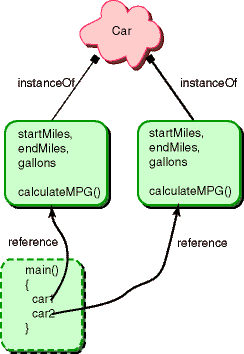Picture of the Two-objects Program
In this program, two defferent Car objects are constructed,
each with different data,
and the miles per gallon calculation is performed on each.
import java.io.* ;
class Car
{
. . . .
}
class MilesPerGallon
{
public static void main( String[] args )
{
Car car1 = new Car( 32456, 32810, 10.6 );
System.out.println( "Miles per gallon of car 1 is "
+ car1.calculateMPG() );
Car car2 = new Car( 100000, 100300, 10.6 );
System.out.println( "Miles per gallon of car 2 is "
+ car2.calculateMPG() );
}
}

The picture shows the situation just after the second object has been constructed:
Notice that there is one class definition, two objects, and one static main().
